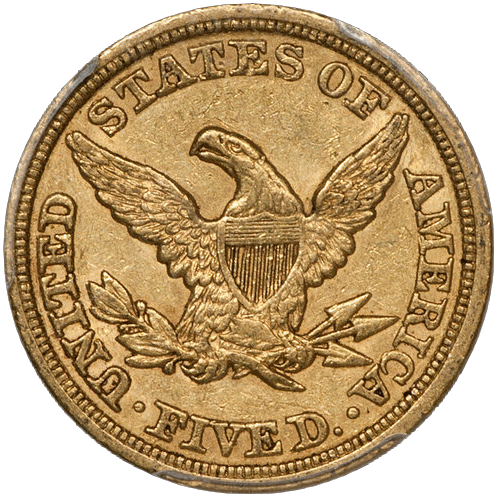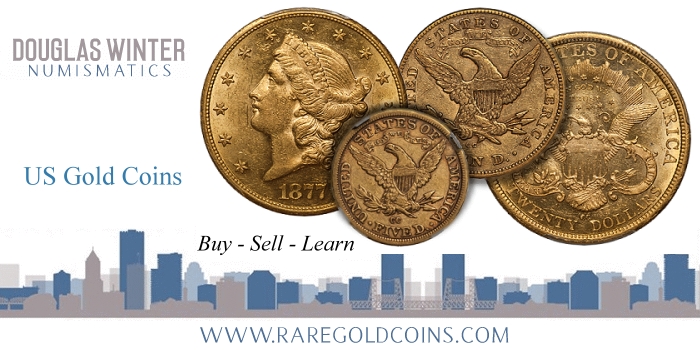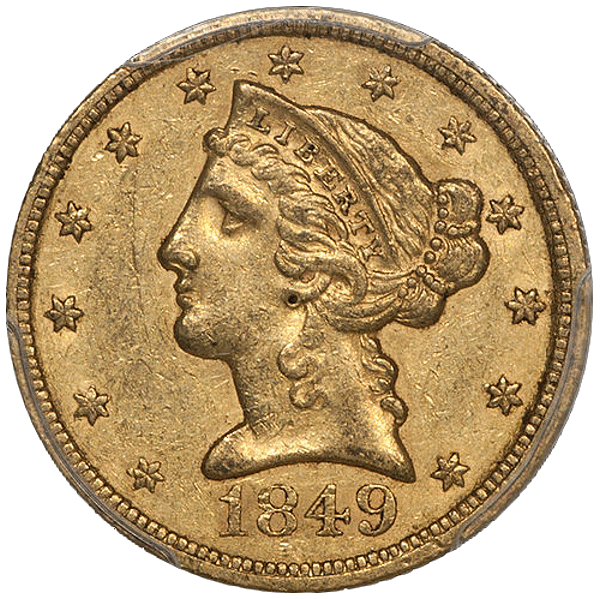1849 $5.00 PCGS AU55 CAC. Images courtesy Doug Winter Numismatics (DWN)
By Doug Winter – RareGoldcoins.com
CoinWeek Content Partner ……
The rare date gold market is now fairly mature and many areas which were formerly overlooked and undervalued (like San Francisco half eagles and eagles, New Orleans half eagles and eagles and Type One Liberty Head double eagles) are now very popular with collectors. There are still coins which are “sleepers” but you just have to look harder these days to find them.
I’ve written these words before but I still feel that the No Motto Philadelphia half eagle date run, issued from 1840 through 1865, contains a number of under-appreciated issues. These issues clearly don’t include the 1862-1865, which are now in strong demand due to their Civil War issuance, but they do include nearly all the dates made between 1840 and 1861.
I was recently able to pick a few dozen nice About Uncirculated common and slightly better date No Motto Philadelphia half eagles from a remarkable group of pieces that has been in Europe until recently. These coins, all of which are freshly graded by PCGS and in some cases approved by CAC, are amazingly fresh and have a century’s worth of dirt caked over undipped, vibrant surfaces. I will soon be offering these to my DWN Preferred Clients via a series of emails.
 1. They Come Nice
1. They Come Nice
Unlike branch mint half eagles which are typically found bright from having been processed, some of these Philadelphia No Motto half eagles because of a variety of factors (mainly due to their relatively low value) come with lovely, natural color. Many of the coins graded AU53 or even AU55 are under-graded but it doesn’t pay to try these multiple times at PCGS due to lack of upside. This is clearly not the case for, say, Charlotte half eagles, where an upgrade from 53 to 55 can mean a few thousand dollars.
2. They Are Affordable, Even In Relatively High Grades
I can think of more than a dozen No Motto P mint half eagles that are $1,000 or less in nice AU, and many of these are less than $2,000 in MS61. If you don’t have the $5,000-10,000+ per coin budget it takes to be a player in the Southern branch mint half eagle market, you can buy really nice coins in the Philadelphia half eagle market at a price point that’s still be in your comfort zone.
3. You Can Assemble Impressive Date Runs
Looking at the 1840-1857 Philadelphia half eagles, one thing I immediately see is the possibility of assembling long date runs. Here is my quick analysis of these coins:
LEVEL ONE: RARE
- 1842 Small Letters
- 1842 Large Letters
Both are rare coins with well under 100 known per issue. Despite this fact, it is possible to purchase a very decent example of one or both in the $2,500-3,500+ price range.
LEVEL TWO: SCARCE
- 1840 Wide Mill
- 1841
- 1850
- 1859
- 1860
All five of these dates are scarce, especially in higher grades. That said, it is possible to acquire a decent example of each in the $1,500-2,500 range. The 1840 Wide Mill is an optional issue but as it is easy to see with the naked eye, I generally include it as a “regular issue.”
LEVEL THREE: MODERATELY SCARCE
- 1846 Large Date
- 1849
- 1858
These three dates are somewhat challenging but with patience, the collector should be able to procure nice examples in the $1,000-1,500 range.
LEVEL FOUR: COMMON
- 1840 Narrow Mill
- 1843
- 1844
- 1845
- 1846 Small Date
- 1847
- 1848
- 1851
- 1852
- 1853
- 1854
- 1855
- 1856
- 1857
- 1861
No less than 15 dates in this series are what I would call “common.” It is possible to acquire a nice, crusty AU example of any of these dates in the $750-1,250 range.
4. Abundant Varieties = Uncharted Territory
If you are the sort of collector who likes to chart undiscovered numismatic waters, then Philadelphia No Motto half eagles are for you. Because of their relatively high mintage figures, it is likely that a host of interesting varieties exist for these coins. Some, like the 1847 with an errant 1 placed in Liberty’s neck, the 1849 double date, or the 1854 with a noticeably doubled earlobe are already semi-well known. But others are waiting to be discovered or re-discovered. And there is the possibility of cherrypicking new varieties with no price premium.
Note: I would suggest buying a set of the three Bass catalogs (issued by Bowers and Merena in 1999 and 2000) devoted to selling Liberty Head gold coins. Bass was a fervent collector of half eagle varieties and his holdings serve as a roadmap to the nascent variety collector.
5. Small Premiums
According to the website coinflation.com, the melt price for a Liberty Head half eagle (based on current gold spot of $1,322/oz.) is $319.72. When you consider that you can purchase a common date No Motto Philadelphia half eagle in nice AU for less than $800, that seems like awfully good value. Put another way, you are paying just over two times melt for a numismatically desirable coin.
There are interesting numismatic comparisons to make as well. Let’s take the 1849-P in AU55 as an example. The current PCGS population is nine in this grade with 20 finer. You can buy one for under $1,500. Let’s compare it to its southern counterpart, the 1849-C. In AU55, PCGS has graded 26 with 22 finer. You’ll spend around $4,000 for a decent PCGS example.
Do the math: doesn’t the 1849-P seems pretty undervalued in comparison to the 1849-C?

About Doug Winter
 Doug has spent much of his life in the field of numismatics; beginning collecting coins at the age of seven, and by the time he was 10 years old, buying and selling coins at conventions in the New York City area.
Doug has spent much of his life in the field of numismatics; beginning collecting coins at the age of seven, and by the time he was 10 years old, buying and selling coins at conventions in the New York City area.
In 1989, he founded Douglas Winter Numismatics, and his firm specializes in buying and selling choice and rare United States coins, especially US gold coins and all branch mint material.
Recognized as one of the leading specialized numismatic firms, Doug is an award winning author of over a dozen numismatic books and the recognized expert on US Gold. His knowledge and exceptional eye for properly graded and original coins has made him one of the most respected figures in the numismatic community and a sought after dealer by collectors and investors looking for professional personalized service, a select inventory of impeccable quality and fair and honest pricing. Doug is also a major buyer of all US coins and is always looking to purchase collections both large and small. He can be reached at 214-675-9897.
Doug has been a contributor to the Guidebook of United States Coins (also known as the “Redbook”) since 1983, Walter Breen’s Encyclopedia of United States and Colonial Coins, Q. David Bowers’ Encyclopedia of United States Silver Dollars and Andrew Pollock’s United States Pattern and Related Issues
In addition he has authored 13 books on US Gold coins including:
- Gold Coins of the New Orleans Mint: 1839-1909
- Gold Coins of the Carson City Mint: 1870 – 1893
- Gold Coins of the Charlotte Mint: 1838-1861
- Gold Coins of the Dahlonega Mint 1838-1861
- The United States $3 Gold Pieces 1854-1889
- Carson City Gold Coinage 1870-1893: A Rarity and Condition Census Update
- An Insider’s Guide to Collecting Type One Double Eagles
- The Connoisseur’s Guide to United States Gold Coins
- A Collector’s Guide To Indian Head Quarter Eagles
- The Acadiana Collection of New Orleans Coinage
- Type Three Double Eagles, 1877-1907: A Numismatic History and Analysis
- Gold Coins of the Dahlonega Mint, 1838-1861: A Numismatic History and Analysis
- Type Two Double Eagles, 1866-1876: A Numismatic History and Analysis
Finally Doug is a member of virtually every major numismatic organization, professional trade group and major coin association in the US.
If you are interested in buying or selling classic US coins or if you would like to have the world’s leading expert work with you assembling a set of coins? Contact Doug Winter at (214) 675-9897 or by email at [email protected].





